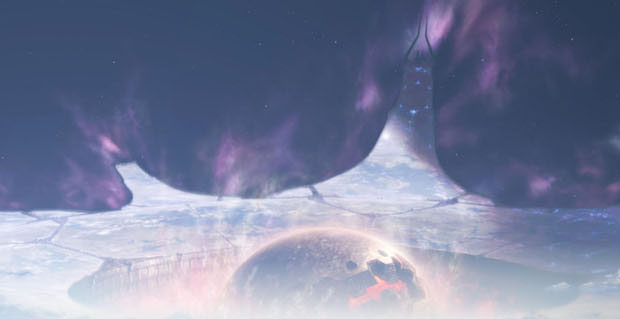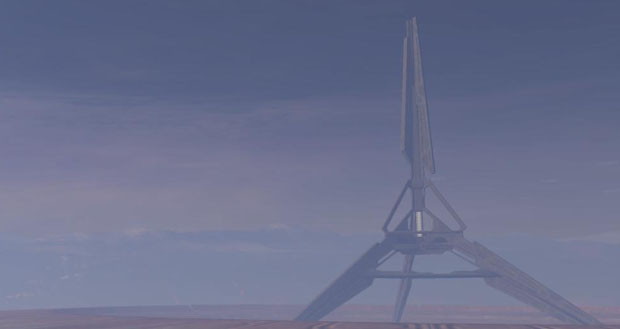Unworlding (Page One)

Of all the ingredients that go into the tapestry of Halo’s fiction, not one resonates with its cast of characters more emphatically than the notion of the Great Journey. Interestingly, although not surprisingly, this is the one ingredient we know the least about. Many only know that the term, “Great Journey,” was employed by the Covenant hierarchs when they laid the foundation for their religion. But, as you might expect, there is much more to the matter than simple eschatological archeology and galactic conquest.
However one shapes their understanding of the Great Journey it is likely to find its way back into the arms of the hegemonic stratagem of the Covenant. Our introduction to this divine pathway is revealed in the first Halo game, when Cortana explains that the connection between the Halo installation and the Covenant is deeply religious.
Shortly later, we learn the frighteningly harrowing details of the matter: the Covenant believe that firing the weapon will bring them into nirvana and offer them unlimited power, but in reality, it will do the opposite. The Halo Array, when fired, would wipe the galaxy clean of all biological sentience. The entire crux of the Halo trilogy is embodied in the rather broad objective of stopping the Covenant from doing this.
However, for the purpose of this exercise, let’s go back to the furthest roots of their religion and determine what exactly put the galaxy into peril through the eyes of insanity and at the behest of something called the Great Journey.
ANATHEMA AT DAWN
The Covenant developed their system of belief like most others — based on the presupposition of an afterlife.
The birth of their philosophy traces back to the San ‘Shyuum and their own brutal civil war. Ages before the Covenant was even an ethos, the Prophets, as they are now known, underwent a violent and traumatic series of events which divided their race permanently. History claims that the San ‘Shyuum first discovered the Forerunner artifacts on their own world, including the grand and massive dreadnought, all of which became the foundation in their quest for the metaphysical.
Choosing only to worship these items at the time, the fledgling belief originated around the basis that if one chose to apply sincere deference to these holy relics, they would achieve an eventual transcendence like the Forerunners who came before them. They would become gods. For ages, the San ‘Shyuum were united on this front, but at some indiscernible point in their history, a schism began to form.
The cracks first appeared when a group of Prophets started to debate the validity of the artifacts’ ability to transform them if they were never studied, used or manipulated. And so, a line was quickly drawn in the sand between the Reformists who sought to uncover more secrets and knowledge by reverse engineering the mysterious technology and the Stoics who believed it was heresy to even consider such things. Looking back, we have to believe that this was the first true beginning of the Covenant religion, as nothing in the creed’s embryonic incarnation leveraged it toward a violent pursuit of the technology until this point.
So began the protracted conflict of the last San ‘Shyuum war.
We know little about this war or the manner in which it was waged, but we do know that at its zenith, when all hope for any peace seemed to be lost, a cult of zealot Reformists broke into hallowed control center of the Forerunner dreadnought and did something radical. The massive ship was finally activated and rent from its tether, rising from their homeworld. The Reformists had taken the vessel and fled into space. What became of their birth planet is not known, but in their final breath, the Stoics released a curse on the departing Reformists, claiming that this was never the intent of the Forerunners and that they would be doomed.
They were right.

SALVATION BY THE SWORD
At some point, well after the flight from their planet, the Reformists aboard the dreadnought began to formulate ways to not only influence the Forerunner artifacts, but to make practical use of their inherent technology. As they gained knowledge and wisdom from their research, the Reformists began to move throughout the galaxy in an effort to collect even more evidence of the Forerunner’s divinity and perhaps, a way in which they could share such transcendence.
Synchronically, another race of beings known as the Sangheili, or Elites, also found themselves on a world abundant with Forerunner relics. They, however, did not fall prey to internecine as the San ‘Shyuum and so they continued, united, to regard the ancient properties as holy and pure and, as one might expect, untouchable. Perhaps it was the militant and feudal nature of their society or a superior sense of ethics, but the Sangheili survived their discovery of the Forerunners and they likely would have continued in this way had it not been for one fateful day.
While excavating relics from a world within one of their own systems, they discovered the San ‘Shyuum. For a short time, they tried to formulate some element of peace between their races, but eventually the spirit of the Reformist still held sway and the Sangheili considered such activity the gravest of all sins. This disagreement, not too unlike the one which came before, became a devastating conflict of wills and ultimately a war.
We don’t know the exact length of the war itself, but we do know that by its end both races verged on extinction. Although the Sangheili had a grand tradition of their own technology and a wealth of warfare experience, it became clear during the heart of the conflict that they would have to forsake their cherished restraint and actually begin using the Forerunner machines for their own survival. At the cost of many warriors and with controversy running deep, the Sangheili culture finally gave in to the temptation in an effort to stem the deadly attacks issued by the unstoppable San ‘Shyuum dreadnought.
At some point, a stalemate became the only acceptable solution. Despite the use of this new technology to stave off what would have been the end of their way of life, the Sangheili could not gain any real victory. Neither could the San ‘Shyuum Reformists, who had been prey to the Sangheilian war machine’s strategic brilliance, its numeric superiority and the inherent disadvantages of waging such a conflict in Sangheili-occupied space.
During this time, the leaders of both the Sangheili and the San ‘Shyuum met and forged an alliance on the equal footing that they would both do all things within their power to seek passageway to the Great Journey through the appropriate use of the Forerunner treasures they had since discovered.
While some part of the San ‘Shyuum’s treaty with the Sangheili had been founded on the idea that both races could better serve each other in this quest, it would not be unrealistic to assume that the Prophets simply realized that their kind would eventually be wiped out regardless of the results of the war. The lack of a reasonably sized gene pool combined with the likelihood of future encounters with resistive alien denizens made the pact with the Sangheili essential — and this, of course, was the formation of the Covenant.
Whether or not the seeds of the belief in the Sacred Rings began back on the San ‘Shyuum homeworld or in the time they spent searching for Forerunner reliquaries prior to their encounter with the Sangheili is unknown. What we do know is that one of the founding principles of the Covenant was the belief in the existence of seven Forerunner-designed ringworlds — collectively known as “Halo” — which, when activated, would open the door into the great beyond and usher the departure of all who were accounted as holy. They believed that this was the path to their reunification with the Forerunners and ultimately, their ascension to the throne of godhood.
This was their Great Journey.